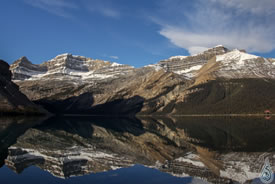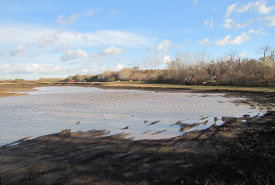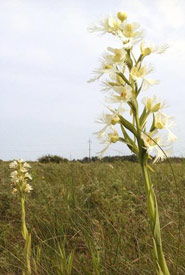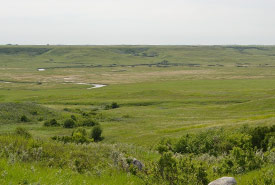Life in freshwater country: How helping water helps Canada (Part Two)

Bow Lake, AB (Photo by Sarah Boon)
In Part One of this blog I presented an overview of Canada's freshwater resources and the need to protect them for people and nature. Here I will further explain how today’s problems need new solutions.
Over the last year the Nature Conservancy of Canada (NCC) has showcased solutions in three projects across Canada through support from the RBC Blue Water Project. These solutions could help us to ensure water sustainability today and in the future:
Life by a thousand cuts
Lake Erie is sick. As the shallowest of the five Great Lakes, it reacts quickly to what flows into it. What’s currently flowing in to the waters of Lake Erie is a soup of nutrients and sediments from the cities and farmlands that now dominate the watershed.
Part of the problem is that for over a hundred years, we’ve been trying to get water off the landscape as quickly as possible. The other part of the problem is that we are very good at this. Steams and drains swell in the rain, and then quickly dry because there are too few forests and wetlands to hold and store water.

Shortly after construction the new wetlands on Pelee Island began to hold water. These sites will revegetate over the next year (Photo by NCC)
The solution to Lake Erie’s woes is simple, but will take time and will need thousands of small acts of conservation. One of the solutions is to restore some of the wetlands that once held water.
On Pelee Island in Ontario, NCC has been strategically restoring wetlands. Excavators were used to dig a series of shallow depressions and cut drains that fast-track water off the land. Within days these new wetlands were filled with water, and being visited by shorebirds (and bird watchers). They will now hold and clean tens of millions of litres of water.
Fixing the dam road

Endangered western prairie fringed orchid – a species that depends on healthy tall grass prairie hydrology (Photo by NCC)
The tall grass region of southern Manitoba is a land of floods. Snowmelt and abundant spring rains are held by the grasslands and wetlands, and provide moisture to plants and wildlife during the hot summer months. Much of this water flows across the landscape, along or just below the surface of the soil. This shallow flow of water supports the region’s unique tallgrass prairies, and globally rare species such as the western prairie fringed orchid.
Unfortunately, these natural, shallow flows have been altered in many areas by roads. Roads can act like dams in the tall grass region by blocking the flow. This impounds water on one side, and dries the other. The ecosystem is left with either too much or too little water.
Restoring the natural hydrology to this special area requires creative conservation. This is a settled landscape, and removing roads is not an option.
NCC scientists in Manitoba are piloting an innovative solution that keeps the roads and restores the flow. By placing a series of small pipes under the road bed, natural flows and water balance can be restored.
This prairie is a river
Lakes, rivers and streams reflect life around them. A lake is more than just a lake; a river is bigger than just the river. The health of land is the health of water.
One of the key links between land and water is runoff. In nature, rain and snowmelt are held on the land by plants. Stems and roots slow the flow. Water percolates into the ground or gently flows into lakes, rivers and streams.
In Saskatchewan, cattle grazing is important to maintain healthy grasslands, and is important to sustaining local ranching families. The problem with cattle is that they are hard to train. Without fences to manage where they go, they can over-graze grasslands and damage sensitive stream banks.

The health of the Qu'Appelle River is linked to the health of the watershed (Photo by NCC)
On NCC’s Stark property along the Qu’Appelle River in Saskatchewan, new fences will protect stream habitats and allow ranchers and land managers to improve the health of grasslands. Healthy prairie equals more water infiltration, equals cleaner water and more water storage, equals healthy river. Healthy rivers also equal healthy communities — the Qu’Appelle is the drinking water source for residents of Moose Jaw and Regina.
Water conservation requires innovation
These are three small, but important steps in restoring Canada’s freshwaters. The good news about our water woes is that we know the solutions. In hundreds of places across Canada we are redefining the relationships between people, land and water. By returning natural flows, restoring key habitats and reducing the pollution from cities and farms, we can restore and maintain healthy freshwaters.
As we look at our conservation compass for the 21st century, it clearly points to freshwater.
We need new conservation innovation. We need the help of business and corporations. Leadership that can help shift market forces of loss and overuse to market forces of conservation and sustainability. Innovation that moves us from pilot projects to business as usual. Inspiration that makes Canada a global leader in water sustainability. Stories that ingrain healthy water into our Canadian culture.
We are all linked by water. Land issues are water issues. Water issues are people issues. Clean, secure water is the foundation of heathy kids, prosperous economies and civil society. Without water, there is nothing.
This blog is based on a presentation given by Dan Kraus to RBC staff on June 2, 2016 in celebration of RBC World Water Day.


